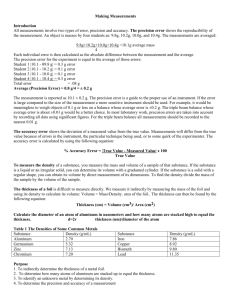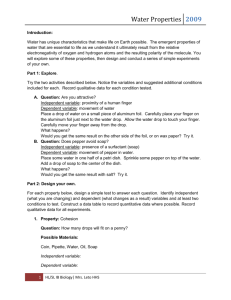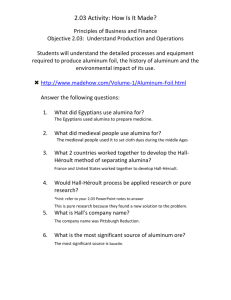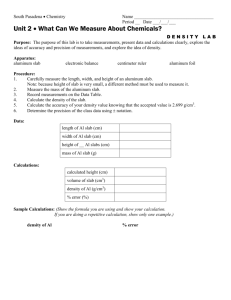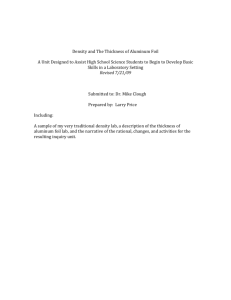Lab 2- Density and thickness of Al foil
advertisement
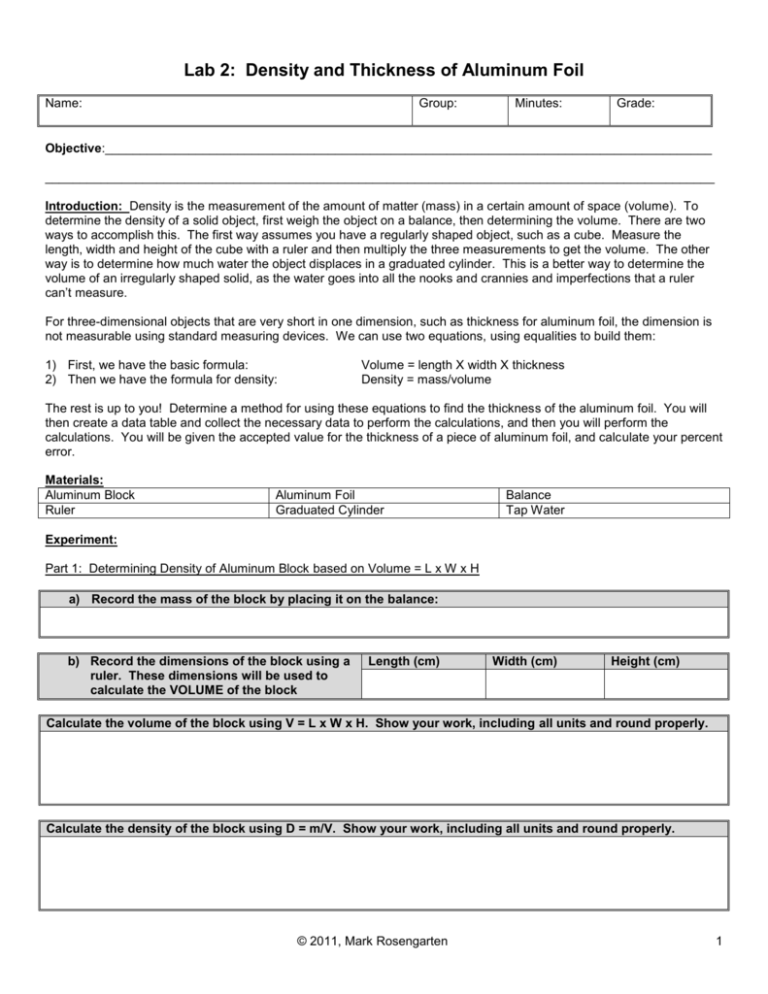
Lab 2: Density and Thickness of Aluminum Foil Name: Group: Minutes: Grade: Objective:_______________________________________________________________________________________ ________________________________________________________________________________________________ Introduction: Density is the measurement of the amount of matter (mass) in a certain amount of space (volume). To determine the density of a solid object, first weigh the object on a balance, then determining the volume. There are two ways to accomplish this. The first way assumes you have a regularly shaped object, such as a cube. Measure the length, width and height of the cube with a ruler and then multiply the three measurements to get the volume. The other way is to determine how much water the object displaces in a graduated cylinder. This is a better way to determine the volume of an irregularly shaped solid, as the water goes into all the nooks and crannies and imperfections that a ruler can’t measure. For three-dimensional objects that are very short in one dimension, such as thickness for aluminum foil, the dimension is not measurable using standard measuring devices. We can use two equations, using equalities to build them: 1) First, we have the basic formula: 2) Then we have the formula for density: Volume = length X width X thickness Density = mass/volume The rest is up to you! Determine a method for using these equations to find the thickness of the aluminum foil. You will then create a data table and collect the necessary data to perform the calculations, and then you will perform the calculations. You will be given the accepted value for the thickness of a piece of aluminum foil, and calculate your percent error. Materials: Aluminum Block Ruler Aluminum Foil Graduated Cylinder Balance Tap Water Experiment: Part 1: Determining Density of Aluminum Block based on Volume = L x W x H a) Record the mass of the block by placing it on the balance: b) Record the dimensions of the block using a ruler. These dimensions will be used to calculate the VOLUME of the block Length (cm) Width (cm) Height (cm) Calculate the volume of the block using V = L x W x H. Show your work, including all units and round properly. Calculate the density of the block using D = m/V. Show your work, including all units and round properly. © 2011, Mark Rosengarten 1 Part 2: Determining Density of Aluminum Block based on Volume From Water Displacement a) Copy the mass of the aluminum block from the previous page: b) Record the volume of the block by water displacement by filling a 25-mL graduated cylinder halfway with water and gently sliding the block down into it. Initial Volume (Vi) (mL) Final Volume (Vf) (mL) Calculate the volume of the block using V = Vf – Vi. Show your work, including all units and round properly. Calculate the density of the block using D = m/V. Show your work, including all units and round properly. Part 3: Determining The Average Density of Aluminum Calculate the density of the aluminum by taking the average of the two densities you calculated in Part 1 and Part 2. Show your work, including all units and round properly. Measurements Calculations Teacher Check Part 4: Determining the Thickness of Aluminum Foil 1) Using the two formulas given in the introduction, come up with a way to mathematically determined the thickness of a piece of aluminum foil. This should be in the form of a single equation, with a thickness on the left side of the =, and the rest of the equation on the right side of the =. 2) Create a data table that includes all of the measurements you will need to make up for this calculation. Before you begin the experiment, your equation and your data table must be checked by your teacher. At that point your teacher will give you a piece of aluminum foil. 3) Obtain a piece of aluminum foil. Be sure not to bend, fold, spindle, or otherwise mutilate the foil, as it needs to be returned at the end of the experiment. 4) Take your measurements, reporting your data in the data table with all numbers to the correct place, and units after each number. 5) Call the teacher over to check your work. Once correct, the teacher will give you the accepted value for the thickness of the aluminum foil. © 2011, Mark Rosengarten 2 © 2011, Mark Rosengarten 3 Part 4: Determining The Thickness of the Aluminum Foil, continued: Create your data table here. You may not have to use all of the spaces, but I provide them to you for your use. Measurement Value Measurement Value a) Calculate the thickness of the piece of aluminum foil. Show your work below: formula, numbers with units substituted in the formula and the answer rounded to the proper place. Use the formula that your group created. b) Accepted Value given to you by your teacher: Accepted Value (cm) c) Calculate the percent error of your calculated thickness for the aluminum foil. Show your work below: formula, numbers with units substituted in the formula and the answer with the proper number of significant figures. Look up the equation for this calculation on Reference Table T. Percent error is an absolute value (negative values become positive). The units cancel out and leave % after the final number. Measurements Thickness % Error Teacher Check © 2011, Mark Rosengarten 4 Supplementary Questions: Answer questions 1 and 2 below in the space provided, the rest of the questions are to be answered on another sheet of paper. ALL work must be shown for questions 6-10, including the formula to be used, the formula rearranged algebraically to solve for the desired variable, the measurements and units substituted into the formula and a properly rounded answer given, highlighted by either circling it or putting a box around it. 1) Complete the following chart (no sentence required): Measuring Device Precision (place measurement was made to ) Balance Units used Centimeter Ruler Graduated Cylinder 2) Look at the following measurements and identify the number of significant figures each one contains and to which place each measurement was made (no sentence required): Measurement # Of Sig Figs Precision (place) 2.304 g 10.01 cm 12.0 oC 0.095 g 75.2 mL 3) Our electronic balances measure mass to the nearest 0.01 gram. Explain, in complete sentences, which balance has the greater precision, the beam balance that you used in this lab or the electronic balance. 4) What are the rules for determining how to round answers obtained by multiplying or dividing measurements? Explain in complete sentences. 5) What are the rules for determining how to round answers obtained by adding or subtracting measurements? Explain in complete sentences. 6) The mass of a sample of gold is 8.54 g and its volume is 0.4421 cm 3. Calculate the density of the gold. 7) The density of copper at 20.0oC is 8.96 g/cm3. What mass would occupy a volume of 24 cm3? 8) The density of silver is 10.5 g/cm3. What is the volume of 31.55 grams of silver? 9) A piece of paper is known to have an area of 30.2 cm2 and has a volume of 5.2 x 10-3 cm3. What is the thickness of this paper? Area is equal to length x width. And, for the AE Chemistry classes only: 10) Apparently by mistake, an Exxon oil tanker spilled 1.0 x 106 kg of oil off the coast of Alaska. If the density of this oil was 0.750 g/cm3 and the slick spread until it was 10 cm thick, what is the area covered by the slick? You will need to convert some values (you can’t mix kg and g). Be on the lookout for this, and use appropriate significant figures. Show your work: formula, numbers with units substituted in the formula and the answer with the proper number of significant figures © 2011, Mark Rosengarten 5


